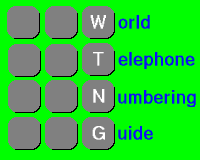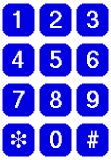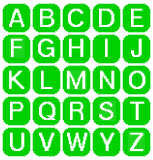


 Main Page
Main Page
 Calendar
Calendar
 Glossary
Glossary
 History
History
 Regional Services
Regional Services
 Special Services
Special Services
 What's New
What's New

|
|
|
| Updated 5 February 2018 | By Country Code | By Country Name | Other WTNG pages | Acknowledgements | ||

|

|

|
 Main Page
Main Page
 Calendar
Calendar
 Glossary
Glossary
 History
History
 Regional Services
Regional Services
 Special Services
Special Services
 What's New
What's New
|
|
||
|
|
Mexico | +52 | ||||
Area Code: 1-3 digits (see note below) Subscriber Number: 5-7 digits (see note below) Trunk Prefix: 01 (see note below) International Prefix: 00 (see note below)
Area codes begin with any digit except 0.
Subscriber numbers can begin with any digit except 0 or 9 (but may begin with 1 in many cases).
While Mexico City area code is 55 (i.e. numbers are in form +52 55 xxxxxxxx), some suburbs of Mexico City use area codes in the 59x format (i.e. +52 59x xxxxxxx format).
Area code in Mexico is called 'NIR' (Region Identification Number) or "Clave Lada".
Calls from outside Mexico will use the +52 1 prefix to identify "calling party pays" status e.g. +52 1 + national number.
Source: IFT announcement (12 May 2015 via ITU)
Callers using the 045 prefix were charged an increased rate per minute with this change (details unclear). The mobile/cellphone user who is called will not be charged for incoming calls through 045.
045 access applies to the carriers Baja Celular, Iusacell, Iusatel, Portatel del Sureste, Telcel, Telecomunicaciones del Golfo Telefonica, Telefonia Celular del Norte, Telefonos del Noroeste, Telmex, Unefon.
From outside Mexico, mobile numbers are reached by +52 1 before the area code and subscriber number, rather than +52 45.
(News courtesy Juanita Boutwell)
Sources:
COFETEL Press Release 21/2006 (PDF)
Lee Iwan bulletin on Mexico cell phone dialling changes (12 October 2006)
Most of the renumbering programme is expected to be completed when the new number lengths must be used from other countries as of 16 February 2002.
Explanations of the national renumbering may be found on CFT site (government regulator, in Spanish language).
The Comision Federal de Telecomunicaciones (COFETEL) is the national telecom regulator, responsible for Mexico's telephone numbering.
AT&T notice on Mexican changes.
Sprint notice on Mexican changes.
Mexican Consulate notes on renumbering.
Mexico City subscriber numbers became 8 digits by prepending 5 to all local numbers as of 27 February 1999. Details are available (in Spanish) at:
http://www.cofetel.gob.mx/html/1_cft/9cam/2aetapa.html
The schedule for all these changes, provided by state, can be found at the following site:
http://www.cofetel.gob.mx/html/1_cft/9cam/base.html
http://www.cofetel.gob.mx/html/1_cft/9cam/base.html
The national renumbering process will conclude December 2001 when the national number is finally expanded to 10 digits.
"There seem to have been some last-minute changes to the new area codes. I downloaded the conversion program from Cofetel; the program is provided by Iusacell, a major cellular carrier. Where it gives 666 as the new code for Tijuana, Cofetel's new table gives 664, as did the original Cofetel tables. The Iusacell program shows 646 for Ensenada, as does Cofetel's new table, but the original Cofetel tables showed 611. ?? Meanwhile, the old +52 plus eight digits still work from here, via Sprint at least."
(Telmex at one point had two downloadable programs: 100principales.exe (100 biggest cities) and claveslada.exe (whole country). However, these links no longer seem to exist).
This consolidation is based on municipal boundaries in the majority of the cases - a local calling area will resemble the boundaries of towns and cities.
Additionally, this action reduces the number of calling areas from 1464 to 406. A map containing all the new calling areas and the dates of their consolidation can be found on the following URL:
http://www.cofetel.gob.mx/html/1_cft/bol99/2_Consol/mapacons.html
April 2002 report from Hugh M. Hamilton regarding Sprint's handling of the Mexican numbering changes:
"Sprint is really shining with the Mexican renumbering. Now, when an old 011 52 + eight-digit number is dialled, an announcement in English (with a Spanish-language option) allows as how the area codes have all changed, then reads off the new 10-digit number, and then completes the call to the new number. Pretty slick."
1) Numbers as they were initially structured prior to the start of the national renumbering process;
2) The First Phase to be completed by the end of 2000;
3) The Second Phase which adds the two area code digits beyond 2000.
The new area codes will eventually relate to the restructured local calling areas.
In some cases (such as Guaymas and Tecate below), the Second Phase area code will be the same as before this renumbering.
Older numbering structures (in effect many years prior to 1999) are noted in brackets for historical reference.
Locality Initial First Phase Second Phase ======== ============ ============ ============== Durango, Dgo (18) 123-xxx (1) 812-3xxx (618) 812-3xxx Ensenada, BC (61) 78-xxxx (6) 178-xxxx (611) 178-xxxx [old: (617) 8-xxxx] Guadalajara, Jal (3) 613-xxxx 3613-xxxx (33) 3613-xxxx [old: (362) 3-xxxx --> (36) 13-xxxx] Guaymas, Son (622) 1-xxxx (6) 221-xxxx (622) 221-xxxx Mexicali, BCN (65) 62-xxxx (6) 562-xxxx (655) 562-xxxx [old: (656) 2-xxxx] Mexico, DF (5) 518-xxxx 5518-xxxx (55) 5518-xxxx [old: (25) 18-xxxx --> (55) 18-xxxx] Monterrey, NL (8) 343-xxxx 8343-xxxx (81) 8343-xxxx [old: (83) 43-xxxx] Tecate, BCN (665) 4-xxxx (6) 654-xxxx (665) 654-xxxx Tijuana, BCN (66) 85-xxxx (6) 685-xxxx (664) 685-xxxx [old: (668) 5-xxxx]
Mexican regulator's explanation of the national renumbering.
Index to new codes (by local calling area, with area codes listed under NIR).
The Mexico Telecom Regulator has made available a Spanish-language document for the Fundamental Technical Numbering Plan of 20 June 1996. (info courtesy Mark J Cuccia).
Telmex expanded the two-digit '0X' service codes (for emergency, directory assistance, etc) to a three-digit '0XX' format.
Introduction of competitive long distance carrier selection began 1997 in major centres. Three-digit carrier identification codes will be used to select particular carriers for calls.
Long distance prefix codes (domestic and international) are also changing to accommodate competitive long distance carriers. The international calling prefix, at least in the Tijuana region, has been changed to the international standard 00+ as from 6 March 1997 (from 95+ for North American calls, 98+ for other nations). (Source was Telnor, which may no longer have details on its site).
Telmex is another Mexican carrier which may have additional information on numbering changes.
(Mexico news and detail courtesy courtesy of Mark Cuccia, Hugh M. Hamilton and Antonio Romo Fragoso).
http://www.cofetel.gob.mx/html/1_cft/bol99/jul99/bol29_22jul.html.
Also as from 15 January 1999, a new scheme for calling the following special service and operator codes became mandatory:
(courtesy Antonio Romo Fragoso)
The former Mexico access area codes were reassigned within the North American Numbering Plan: 905 to Ontario, Canada in 1993 (to split the former area code 416 territory); 706 to Georgia, USA 1992 (to split the former area code 404 territory); 903 to Texas, USA in 1990-91 (to split the former area code 214 territory).
No information is available on when area code 905 was originally assigned for North American access to Mexico City.
300 - calling/called parties share charges
500 - personal numbers with call-transfer (caller pays local charge)
700 - virtual private network carrier access
800 - toll-free
888 - additional toll-free (no word if this is in service yet)
900 - surcharged provided services
 Return to Top
Return to Top